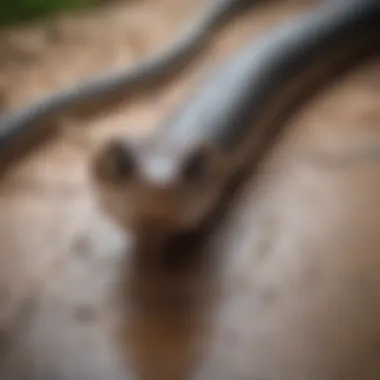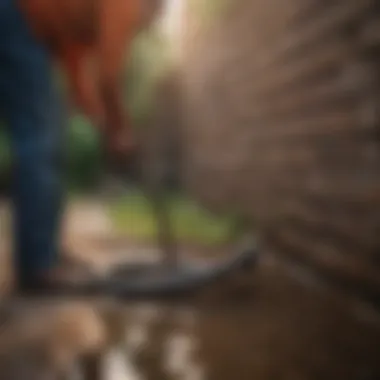Understanding Drain Snakes: A Comprehensive Guide


Intro
Drain snakes serve as an essential tool for homeowners and those involved in property maintenance. Clogged drains can lead to significant issues, including unpleasant odors and potential damage to property structures. Understanding the various types of drain snakes, their functions, and their proper usage is crucial for efficient maintenance. This guide dives into the practical aspects of drain snakes, from their operational mechanics to valuable tips that ensure effective problem resolution in plumbing systems.
Home Features
When dealing with home maintenance, understanding the features that contribute to plumbing system effectiveness is important. Drain snakes come into play, providing a reliable method for clearing clogs. Many homes have multiple drains that can become obstructed due to accumulated debris. Identifying the points where clogs are likely to occur can aid in preventive maintenance.
Common Problem Areas
Most drainage systems in homes can encounter issues due to the following:
- Kitchen sinks: Food particles and grease can create significant blockages.
- Bathroom sinks: Hair and soap scum are typical substances causing clogs.
- Toilets: Flushing inappropriate items can easily lead to severe blockages.
Understanding these features can guide homeowners in effectively utilizing drain snakes, thereby enhancing overall plumbing health.
Tools and Techniques
Using a drain snake effectively requires a clear understanding of the tool itself. Drain snakes vary significantly in design and application. The commonly used types include:
- Manual drain snakes: These are simple, user-operated tools ideal for light clogs. They require physical effort to operate and are suitable for minor blockages.
- Electric drain snakes: These machines automate the unblocking process, making them more efficient for severe clogs. They are particularly useful for larger plumbing systems.
- Hydro-jetting: This method employs high-pressure water jets to dislodge clogs. It is particularly useful for clearing build-up from pipes over time.
To determine the best method to employ, one must assess the severity and location of the clog.
Effective Usage of Drain Snakes
To utilize a drain snake effectively, follow these steps:
- Assess the clog: Determine the location and severity.
- Choose the right tool: Select between manual or electric snake based on the clog's nature.
- Insert the snake: Carefully guide the snake into the drain until resistance is felt.
- Operate cautiously: Use a steady motion to break through the blockage. Avoid excessive force to prevent pipe damage.
- Retrieve and clean the tool: Once cleared, remove the snake, ensuring to clean it thoroughly to prevent further contamination.
"Regular maintenance can prevent clogs from becoming severe issues. A drain snake is an invaluable tool in this effort."
Best Practices and Safety Precautions
While using a drain snake is often straightforward, certain safety practices must be observed:
- Wear protective gear: Gloves and goggles are essential to protect against debris and harmful bacteria.
- Inspect the tool: Ensure your drain snake is in proper working condition to avoid accidents.
- Follow manufacturer instructions: Each product may have unique operational guidelines, making this important for successful use.
Employing these best practices can mitigate risks and enhance effectiveness.
Alternatives to Drain Snakes
Though drain snakes are a common solution for clogged drains, there are also alternatives worth exploring. Some of these options include:
- Plumbing augers: Useful for more stubborn blockages, these tools provide strength and reach.
- Chemical drain cleaners: Chemical solutions can clear minor clogs but should be used with caution due to potential pipe damage.
- Professional plumbing services: For significant or persistent clogs, seeking professional help may save time and effort.
In summary, understanding drain snakes is an invaluable asset for homeowners. By recognizing their functions, practicing effective usage, and adhering to safety measures, individuals can ensure their drainage systems remain clear and functioning well.
Prelims to Drain Snakes
Understanding drain snakes is essential for anyone responsible for maintaining a home. Clogs can disrupt daily activities and lead to costly repairs if not addressed. A drain snake is a simple yet effective tool that helps to clear blockages from drains, making it a staple in normal home maintenance routines.
This section discusses two main elements: the definition and purpose of drain snakes, along with their importance.
Definition and Purpose
A drain snake, sometimes referred to as a plumber's snake or drain auger, is a flexible tool designed to remove blockages in plumbing systems. It typically consists of a coiled metal wire with a turning handle, allowing the user to insert it deep into pipes. Its purpose is straightforward—dislodge clogs caused by hair, grease, and other debris that accumulate in drains over time.


There are various types of drain snakes, each serving a specific need, from manual handheld models to electric versions for heavier jobs. Understanding which type to use is crucial for effective clog removal.
Importance in Home Maintenance
Drain snakes play a pivotal role in home maintenance for several reasons. First, they facilitate the prompt removal of clogs, preventing water backup that can lead to more severe issues such as flooding or sewer line damage. Second, using a drain snake can help avoid the use of harsh chemical drain cleaners, which can be damaging to pipes and the environment.
Moreover, regular use of a drain snake can prolong the life of a home’s plumbing system. Engaging in proactive maintenance with this tool can mitigate the risk of costly repairs and ensure that drains operate smoothly.
Types of Drain Snakes
Understanding the different types of drain snakes plays a vital role in effective drain maintenance. Each type offers unique benefits and is suited for specific plumbing situations. Identifying the best option can enhance efficiency in resolving clogs, reduce plumbing issues, and save time and money. Homeowners can make informed decisions, ensuring they have the appropriate tools for various challenges.
Manual Drain Snakes
Manual drain snakes, often referred to as hand snakes or augers, rely on physical strength and skill. These devices are typically made of durable metal or plastic. They come in various sizes and may have features like a coiled tip for gripping debris.
Benefits of Manual Drain Snakes:
- Cost-effective: They generally have a lower initial cost compared to electric models.
- Simplicity: Manual operation means little risk of malfunction.
- Control: Users can manage force and direction, important when navigating bends in pipes.
However, manual drain snakes require physical effort and may not be suitable for severe clogs.
Electric Drain Snakes
Electric drain snakes offer a powerful solution for stubborn clogs. These tools are motorized and can clear drains much faster than manual options. They often come with varying speeds, providing flexibility according to the situation.
Key Advantages of Electric Drain Snakes:
- Efficiency: They can tackle tough blockages quickly.
- Less Physical Strain: Ideal for those who find manual operation difficult.
- Versatile Accessory Options: Many electric models have interchangeable heads for different tasks.
While they are more expensive and require care in handling, their effectiveness makes them a popular choice.
Flexible Drain Snakes
Flexible drain snakes, or toilet augers, feature a long, bendable cable, making them ideal for reaching tight spots. These tools are valuable for sinks and toilets where traditional tools may struggle.
Strengths of Flexible Drain Snakes:
- Adaptability: They navigate through bends and curves in pipes.
- Specificity: Designed for unique drainage systems like toilets.
- Ease of Use: Usually lighter and more manageable than bulkier models.
Users should be cautious, as improper use can damage porcelain fixtures.
Heavy-Duty Models
Heavy-duty drain snakes are designed for industrial or commercial use. These models often have robust construction and significant power to deal with extensive clogs in major drainage systems or large pipes.
Essential Features of Heavy-Duty Models:
- Durability: Built to withstand challenging conditions.
- High Capacity: Can clear more considerable debris from larger pipes.
- Speed and Power: Designed specifically for professional use.
While these models can be a good investment for commercial applications, they may be unnecessary for typical household use.
Common Drain Issues
Understanding common drain issues is essential for homeowners who wish to maintain effective drainage systems. When drains get clogged, the effects can extend beyond mere inconvenience. Persisting issues can lead to unpleasant odors, water damage, and costly repairs. Identifying the sources of these clogs is vital for effective maintenance and prevention strategies.
Clogs from Hair and Debris
Clogs caused by hair and debris are one of the most frequent problems faced in household drainage systems. Hair tends to accumulate in shower and sink drains, often intertwining with soap residue and other materials. This buildup can quickly form a thick blockage, leading to slow drainage or complete obstruction. Regular maintenance, such as using a mesh screen to catch hair or performing periodic clean-ups, can greatly reduce the chances of severe clogs. Furthermore, using a drain snake can help dislodge and remove these blockages.


Grease Buildup
Grease and fats are other significant contributors to drain clogs. When cooking, excess grease may wash down the sink but solidifies as it cools, creating sticky buildup inside the pipes. This accumulation can trap other waste, worsening the blockage. To prevent grease buildup, avoid pouring fats down the drain and consider using a strainer to catch food particles. If a clog does occur, a drain snake can effectively break up and remove the greasy residue, restoring proper flow.
Tree Root Intrusion
Tree root intrusion poses a more complex issue for drainage systems. Roots can infiltrate cracks or joints in underground pipes, seeking moisture. This invasion can lead to significant blockages and may cause pipes to break or distort over time. Homeowners should keep an eye on the proximity of large trees to their drainage systems. If root intrusion is suspected, a professional inspection may be necessary. In some cases, drain snakes equipped with specific attachments can help clear roots without requiring excavation.
Structural Damage in Old Pipes
Old drainage systems often suffer from structural damage due to wear and age. Pipes may corrode, crack, or collapse, leading to noticeable drainage problems. This type of issue can be particularly insidious, as it may manifest slowly over time. Regular inspections can help detect such problems early. If damage is detected, it may require replacement or major repair, beyond what a drain snake can resolve. Keeping your drainage system in good condition prolongs its lifespan and prevents costly repairs.
Using a Drain Snake Effectively
Using a drain snake effectively is essential for maintaining plumbing systems at home. It allows one to address clogs and prevent potential damage to pipes. Knowing how to use a drain snake can save time and money by avoiding professional services. This section will guide readers through the proper steps and considerations necessary for effective use.
Preparing for Use
Before using a drain snake, preparation is key. First, gather all necessary tools and safety equipment. Wear gloves, goggles, and a face mask to protect against debris and harmful materials. Ensure the area around the drain is clear. Remove any obstacles that could hinder access.
Next, inspect the drain. Understanding the type of clog is important. This can determine which type of drain snake will be best for the situation. Having a clear plan will make the process smoother.
Step-by-Step Instructions
- Choose the Right Snake: Depending on the clog's nature, select either a manual or an electric drain snake. Manual snakes are good for small clogs, while electric models handle larger blockages more effectively.
- Insert the Snake: Carefully insert the snake into the drain. Push it in gently while turning the handle. Avoid forcing it, as this could cause damage to the pipe.
- Engage the Clog: Once it feels resistance, continue turning the handle. This motion will help the snake catch the clog or break it apart.
- Remove the Clog: Pull back the snake slowly while continuing to turn. This will extract the debris from the drain. Once the clog is visible, dispose of it properly.
- Test the Drain: After clearing, run water to ensure proper drainage. Check for any residual issues that may require further attention.
Following this methodical approach can increase the chances of successfully clearing the drain with minimal complications.
Post-Usage Cleaning and Maintenance
After using a drain snake, prompt cleaning and maintenance can extend its life and ensure readiness for future use. Clean the snake with water and a mild detergent. This removes any grime or residue that may remain after the unclogging process.
Ensure the snake is completely dried before storing it. This prevents rust and damage. Store it in a dry, accessible location, ideally in its original casing or a dedicated container.
Additionally, conduct a quick inspection on the snake for any wear or tear. If any part is damaged, consider repairing or replacing it.
Maintaining your tools not only safeguards their functionality but also enhances your efficiency during the next use.
Safety Considerations
When dealing with drain snakes, safety is a crucial aspect that cannot be overlooked. Using a drain snake may seem straightforward, but the potential hazards involved necessitate a careful approach. Ensuring safety not only protects you from injuries but also prevents further damage to your plumbing system. This section will discuss essential safety measures that should always be considered.
Personal Protective Equipment
Using the right personal protective equipment (PPE) can significantly reduce the risk of injury while working with drain snakes. Some recommended PPE includes:
- Gloves: These should be thick and durable to protect your hands from sharp edges and hazardous materials that might be in the drain.
- Safety Goggles: Eye protection is vital as debris can splatter during the drain cleaning process.
- Respirators or Masks: This is especially important if you are dealing with chemical residues or unpleasant odors coming from the drain.
- Knee Pads: If the work requires you to kneel, knee pads can ensure comfort and protection.
Investing time to gather appropriate PPE before engaging in any drain cleaning activity is a simple yet effective way to enhance your safety during the process.
Handling Electrical Drains
Working with electrical drains adds another layer of complexity. Proper precautions must be taken to avoid electrocution or damage to electrical components. Here are key points to remember when handling electrical drains:
- Turn Off Power: Always ensure that power to the area is turned off before starting work. Locate the circuit breaker and switch it off.
- Use Insulated Tools: If you need to use tools near electrical components, ensure they have insulated handles to reduce electrocution risk.
- Avoid Water: Keep the area as dry as possible. Water and electricity do not mix. Make sure there is no water pooling where electrical components are present.
- Seek Professional Help: If you are unsure about handling electrical issues, it is better to call a licensed electrician. They can safely manage electrical drains, reducing the risk of mishaps.
Always prioritize safety when working with drain systems! The risks, especially regarding electrical components, are not worth taking lightly.
Alternatives to Drain Snakes


Drain snakes serve as a competent solution for unclogging drains and maintaining water flow. However, sometimes alternatives may be more suitable depending on the specific circumstances surrounding the clog. Understanding what options exist beside drain snakes is crucial for homeowners or individuals looking to efficiently clear blocked drains. Each method has its benefits, limitations, and unique considerations.
Chemical Drain Cleaners
Chemical drain cleaners offer a quick and often effective solution for resolving drain clogs. These products, available in stores, use powerful chemicals that dissolve build-up within pipes. When choosing a chemical cleaner, it is essential to consider the type of clog. Some formulas respond better to grease, while others target hair or organic matter. It’s important to follow the instructions provided by the manufacturer to avoid damage to pipes or unintended reactions.
Plungers
A plunger is a simple yet effective tool against blockages. It creates suction and pressure that can dislodge clogs in toilets, sinks, and tubs. There are multiple types of plungers, such as the cup plunger, which is good for flat surfaces, and the flange plunger, ideal for toilets. While plungers require some physical effort, they are generally safe for most plumbing systems and do not involve the same risks as chemical cleaners.
- Pros of plungers include:
- Cons include:
- Cost-effective
- Safe for various surfaces
- Easy to use
- May not be effective for deeper or more stubborn clogs
- Can require significant physical exertion
Hydro Jetting Services
Hydro jetting involves the use of high-pressure water jets to clean out pipes. This method is especially useful for stubborn clogs caused by grease, sediment, or tree roots. Hydro jetting not only removes current clogs but also prevents future build-ups by thoroughly cleaning the interior of the pipes.
Before opting for hydro jetting, it’s crucial to have a professional inspect the plumbing system to determine if this method is suitable. The costs associated with hydro jetting can be higher than other methods, but it often results in a more thorough clean.
In summary, while drain snakes are effective tools, alternatives like chemical drain cleaners, plungers, and hydro jetting services offer varied benefits. Understanding these options enables individuals to make informed decisions based on the nature of the clog and the long-term maintenance of their plumbing systems.
Maintaining Your Drain System
Maintaining your drain system is crucial for ensuring a well-functioning home. It is not just about clearing clogs when they occur; it involves a proactive approach to keeping your drainage systems clean and efficient. Regular maintenance can prevent serious issues that may require costly repairs or replacements. With proper attention to your drains, the risks of backups and slow drainage can significantly reduce.
One of the core benefits of maintaining your drain system is enhanced longevity. When drains are regularly inspected and cleaned, the materials that can cause corrosion or blockage do not accumulate. This results in less wear and tear. Additionally, a well-maintained drainage system ensures clean water flow, reducing odors and dirty water backing up into your living areas.
It is important to remember that maintaining the drain system is a responsibility that falls on homeowners. Regular action prevents minor issues from escalating and creating bigger problems down the line. By investing time in drain maintenance, you ensure a smoother and more pleasant living environment.
Regular Inspections
Conducting regular inspections of your drain system can save both time and money. These inspections help identify potential problems before they develop into significant issues. During an inspection, pay attention to slow drains or unusual odors. These are often the first signs of a clog or buildup. It is advisable to check your drains at least once every few months.
When inspecting, consider the following:
- Visual Checks: Look for any visible blockages in the drain or pipes.
- Water Flow: Run water to observe how quickly it drains. Slow drainage can be a warning sign.
- Smells: Unpleasant odors can indicate decomposing material in the pipes.
Addressing issues early can prevent costly repairs in the future. Consulting a professional inspector can provide a comprehensive evaluation and advice on maintaining your drain system.
Preventative Measures to Avoid Clogs
Preventative measures play a major role in maintaining your drainage system. By addressing potential problems upfront, you reduce the likelihood of future clogs and associated inconveniences. Here are several effective strategies for maintaining clear drains:
- Use Drain Covers: Installing covers over your drains can prevent debris and hair from entering.
- Regular Cleaning: Periodically clean your drains with appropriate solutions. For instance, vinegar and baking soda can clear small buildups.
- Limit Waste Disposal: Avoid flushing non-biodegradable items or excessive food waste down the sink. These can lead to blockages in the pipes.
- Tree Maintenance: If trees are near your drainage systems, guide their roots away from the pipes to avoid root intrusion.
By implementing these preventative measures, homeowners can significantly decrease the chance of clogs and enhance the overall health of their drains.
"An ounce of prevention is worth a pound of cure."
An organized approach to drain maintenance, including regular inspections and preventative measures, will ensure an efficient and clear drain system. Keeping these factors in mind is essential for a thriving home environment.
End
Understanding drain snakes and their role in home maintenance is essential for every homeowner and design enthusiast alike. Properly maintaining drainage systems not only keeps one’s living environment clean but also ensures efficient functionality. This guide outlined the significant aspects of drain snakes, from types to techniques, emphasizing how they prevent plumbing disasters and costly repairs.
Recap of Key Points
- Definition and Purpose: Drain snakes are tools designed to clear clogs in pipes, especially in sinks and toilets.
- Types of Drain Snakes: Various types exist, including manual, electric, and flexible models, providing options for different needs.
- Common Drain Issues: Hair, grease, tree roots, and structural damage often lead to clogs. Understanding these issues enables proactive maintenance.
- Usage Techniques: Proper preparation and following effective methods enhances the chances of success when using drain snakes.
- Safety Considerations: Awareness of personal protective equipment and electrical concerns is crucial for safe operation.
- Alternatives: In some cases, other tools like chemical cleaners or hydro jetting may serve as effective alternatives to snake usage.
- Maintenance Strategies: Regular inspections and preventive measures can significantly reduce the frequency of clogs.
Final Thoughts on Drain Maintenance
Regular maintenance of drains contributes to the overall health of your home. Utilizing drain snakes is a practical approach to managing clogs, as they can be a reliable first step before escalating to more drastic measures. Understanding how drain systems work can provide homeowners with the knowledge to tackle potential issues proactively. Keeping drains clean is not just about immediate fixes; it also involves adopting habits that prevent problems from arising in the first place. Homeowners should continue learning about their plumbing systems to maintain an efficient and aesthetically pleasing living environment. For more information, check resources like Wikipedia on home maintenance, or Reddit discussions for community tips.



